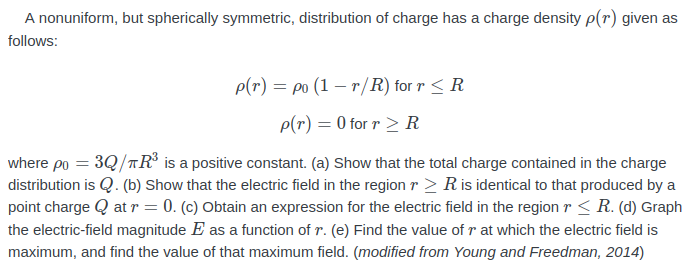A nonuniform, but spherically symmetric, distribution of charge has a charge density p(r) given as follows: p(r) = po (1 – r/R) for r < R p(r) = 0 for r > R where po = 3Q/TR° is a positive constant. (a) Show that the total charge contained in the charge distribution is Q. (b) Show that the electric field in the region r > R is identical to that produced by a point charge Q atr = 0. (c) Obtain an expression for the electric field in the region r < R. (d) Graph the electric-field magnitude E as a function of r. (e) Find the value of r at which the electric field is maximum, and find the value of that maximum field. (modified from Young and Freedman, 2014)
A nonuniform, but spherically symmetric, distribution of charge has a charge density p(r) given as follows: p(r) = po (1 – r/R) for r < R p(r) = 0 for r > R where po = 3Q/TR° is a positive constant. (a) Show that the total charge contained in the charge distribution is Q. (b) Show that the electric field in the region r > R is identical to that produced by a point charge Q atr = 0. (c) Obtain an expression for the electric field in the region r < R. (d) Graph the electric-field magnitude E as a function of r. (e) Find the value of r at which the electric field is maximum, and find the value of that maximum field. (modified from Young and Freedman, 2014)
Chapter6: Gauss's Law
Section: Chapter Questions
Problem 22P: Find the electric flux through a rectangular area 3 cm x 2 cm between parallel plates where there is...
Related questions
Question
Subpart D and E

Transcribed Image Text:A nonuniform, but spherically symmetric, distribution of charge has a charge density p(r) given as
follows:
p(r) = po (1 – r/R) for r < R
p(r) = 0 for r > R
where po = 3Q/TR° is a positive constant. (a) Show that the total charge contained in the charge
distribution is Q. (b) Show that the electric field in the region r > Ris identical to that produced by a
point charge Q at r = 0. (c) Obtain an expression for the electric field in the region r < R. (d) Graph
the electric-field magnitude E as a function of r. (e) Find the value of r at which the electric field is
maximum, and find the value of that maximum field. (modified from Young and Freedman, 2014)
Expert Solution
This question has been solved!
Explore an expertly crafted, step-by-step solution for a thorough understanding of key concepts.
This is a popular solution!
Trending now
This is a popular solution!
Step by step
Solved in 2 steps with 2 images

Knowledge Booster
Learn more about
Need a deep-dive on the concept behind this application? Look no further. Learn more about this topic, physics and related others by exploring similar questions and additional content below.Recommended textbooks for you


Physics for Scientists and Engineers: Foundations…
Physics
ISBN:
9781133939146
Author:
Katz, Debora M.
Publisher:
Cengage Learning


Physics for Scientists and Engineers: Foundations…
Physics
ISBN:
9781133939146
Author:
Katz, Debora M.
Publisher:
Cengage Learning